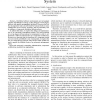Free Online Productivity Tools
i2Speak
i2Symbol
i2OCR
iTex2Img
iWeb2Print
iWeb2Shot
i2Type
iPdf2Split
iPdf2Merge
i2Bopomofo
i2Arabic
i2Style
i2Image
i2PDF
iLatex2Rtf
Sci2ools
116
click to vote
ITNG
2008
IEEE
2008
IEEE
Towards a Model Driven Autonomic Management System
— Distributed software environments are increasingly complex and difficult to manage, as they integrate various legacy software with specific management interfaces. Moreover, the fact that management tasks are performed by humans leads to many configuration errors and low reactivity. This is particularly true in medium or large-scale distributed infrastructures. To address this issue, we explore the design and implementation of an autonomic management system. The main principle is to wrap legacy software pieces in components in order to administrate a software infrastructure as a component architecture. However, we observed that the interfaces of a component model are too low-level and difficult to use. Consequently, we explore the use of a model driven approach where several UML profiles are used to specify the different facets of an autonomic management policy.
Autonomic Management | Information Technology | ITNG 2008 | Legacy Software | Specific Management Interfaces |
Related Content
| Added | 31 May 2010 |
| Updated | 31 May 2010 |
| Type | Conference |
| Year | 2008 |
| Where | ITNG |
| Authors | Laurent Broto, Daniel Hagimont, Estella Annoni, Benoît Combemale, Jean-Paul Bahsoun |
Comments (0)

